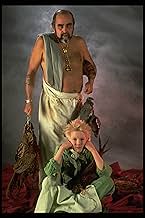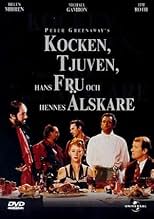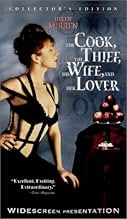O Cozinheiro, o Ladrão, Sua Mulher e o Amante
Título original: The Cook, the Thief, His Wife & Her Lover
A esposa de um criminoso abusivo encontra consolo nos braços de um gentil hóspede regular do restaurante de seu marido.A esposa de um criminoso abusivo encontra consolo nos braços de um gentil hóspede regular do restaurante de seu marido.A esposa de um criminoso abusivo encontra consolo nos braços de um gentil hóspede regular do restaurante de seu marido.
- Prêmios
- 7 vitórias e 11 indicações no total
Ciarán Hinds
- Cory
- (as Ciaran Hinds)
Roger Ashton-Griffiths
- Turpin
- (as Roger Ashton Griffiths)
Avaliações em destaque
My introduction to Greenaway was `Prospero's Books,' which I rate very highly. I next saw `The Pillow Book,' which also was magic. I now delve into this earlier work, which is before Greenaway became master of overlayed windows. And also before he developed (at least in the two films mentioned) a clean sense of layering allegory.
In this early film the sense of allegory is simplistic, and the notion of narrative is largely abandoned. All in all, this is a cleaner film. Greenaway's fulcrum is the creation of a massive clockworks kitchen with dozens of concurrent, interrelated processes. Everything revolves around this, or more precisely the vision of this. Around this center, we see both vile and sublime forces acting on the kitchen, which is a sort of metalevel over the world from which creation emanates.
I suppose many will remember some of the more disturbing incidental images. Not me. I'll remember that extraordinary kitchen.
In this early film the sense of allegory is simplistic, and the notion of narrative is largely abandoned. All in all, this is a cleaner film. Greenaway's fulcrum is the creation of a massive clockworks kitchen with dozens of concurrent, interrelated processes. Everything revolves around this, or more precisely the vision of this. Around this center, we see both vile and sublime forces acting on the kitchen, which is a sort of metalevel over the world from which creation emanates.
I suppose many will remember some of the more disturbing incidental images. Not me. I'll remember that extraordinary kitchen.
I saw this almost fifteen years ago and I still have crystal clear mental images of some of the scenes. The chef at his table in the kitchen, planning his menu: stunning! Put it in a frame, hang it on the wall. In the restaurant scenes, you feel like you're there at the table as the camera pans, without cuts, from one person to another. Our heroes locked in the truck full of rotting meat: horrible, disgusting, perfect. It's a classic purification ritual and it's literally putrid. Greenaway is a genius. My only criticism is a minor one. There is a full frontal nude scene of the wife and her lover, where he is clearly more "relaxed" than he should have been at that moment. I'm a bit disappointed in Greenaway for not showing him at "attention", as he would have been in real life. But then, I guess he would have been accused of making porn. Whatever. This film is not for everyone. My wife didn't see it. I'm sure she would have hated it if she had. For that matter, I can't actually say I liked it, although I consider it a masterwork. But I'm glad I saw it. I'll probably see it again, but not until I can see it on HDTV. Plain old DVD couldn't possibly do it justice. An amazing movie.
Imagine the universe as a restaurant. The parking lot is the world. The kitchen is purgatory. The ladies's room is heaven. The dining room is hell. Hell is ruled over by Albert Spica, (Satan) excellently played by Michael Gobon. Dante is Michael (Alan Howard) a cataloger of French books. Beatrice, Dante's perfect woman, Georgina Spica (Helen Mirren) who is married to the devil.
In the beginning, the cook (God) in the real world is seen kicked and smeared and fed dog feces by Gabon. He is humiliated and in tears, but He endures and eventually helps to further the love between Howard and MIrren. Sex, in its pure form, is looked at as something sacred. Gabon lords over everyone in his realm with a tyrant's fist, caring nothing about anyone or anything. He wants two three things out of lifesuperiority to all other being, food and sex, while Mirren, as a reluctant Persephone, sneaks off to be with Howard. A couple of times Gabon even finds his way into the sanctity of heaven, but this is only short-lived.
The mood of the film is dark-black, heralded by brilliant reds or greens, and the tenor of an angelic child throughout. Every image is like a painting. Emotions creep in from all directions.
This is a film that would never, no matter what year it was produced, have won an Academy Award. It is too refined, to subtle, too sensual, too intelligent.
Watch it, rent it, buy it. It must be seen.
In the beginning, the cook (God) in the real world is seen kicked and smeared and fed dog feces by Gabon. He is humiliated and in tears, but He endures and eventually helps to further the love between Howard and MIrren. Sex, in its pure form, is looked at as something sacred. Gabon lords over everyone in his realm with a tyrant's fist, caring nothing about anyone or anything. He wants two three things out of lifesuperiority to all other being, food and sex, while Mirren, as a reluctant Persephone, sneaks off to be with Howard. A couple of times Gabon even finds his way into the sanctity of heaven, but this is only short-lived.
The mood of the film is dark-black, heralded by brilliant reds or greens, and the tenor of an angelic child throughout. Every image is like a painting. Emotions creep in from all directions.
This is a film that would never, no matter what year it was produced, have won an Academy Award. It is too refined, to subtle, too sensual, too intelligent.
Watch it, rent it, buy it. It must be seen.
With the Cook, the Thief, his Wife and her Lover, Greenaway creates a self-contained world that is both a fabrication and abstraction of reality, but also an extremist reflection (nee, microcosm) of British society in the nineteen-eighties. The characters that he chooses to put forward to the audience as protagonists are archetypes of social and political caricatures that we would find in that particular decade; but heightened to conform to the over-the-top opulence/pestilence found central to the plot. His ability to craft characters and situations that resonate beyond the context of a particular scenario, coupled with his bitterness and unwillingness to conform is what sets him up as a satirist of serious note. He also elevates the film beyond the realms of mere art-house experimentation by fashioning a seriously funny script, which has ample opportunities for central character Albert Spica to prove himself the ultimate charismatic bully - part cockney hard man, part pantomime villain - who is never less than compulsively terrifying.
The plot is a simple construct centred on the theme of revenge and the need for personal freedom. This is mixed in with the socio-political undertones as well as Greenaway's many references to art, theatre, film and literature. It is also elevated by the impeccable cinematic qualities that we hold synonymous with the director's work. Everything here is about pushing things beyond the reasonable limitations; so we have a stunningly intricate set that is both theatrically simplistic, but also as other-worldly as anything from the work of say Gilliam or Jeunet. The costumes by Jean Paul Gaultier scream over-the-top chic, whilst often mirroring the use of colour employed by the production designers. Greenaway even breaks continuity by having Helen Mirren's costumes change colour as she moves through each room of the restaurant, so that we have a green dress in the kitchen, a red dress in the dinning area (inspired by Hitchcock's vertigo no less) and a white dress in the lavatory. It's an audacious move, but one that pays off in the creation of a completely self-contained world; something that is further established by Sacha Vierny's sumptuous cinematography and the wonderfully bombastic music of the ever-excellent Michael Nyman.
Some have clearly found the film's various abstractions problematic (yes, it is theatrical, yes it is occasionally shocking, and yes, it does evolve in a world of its own ostentatious creation). But it's also as artistic a film as you can get; a fact that some here have disputed. The reason that some define this as artistic refers to the use of colour, light and composition. The architecture of the sets too, and the way in which the production designers have chosen to dress them also adds to the artistic stylisation of the film. These factors are important to the narrative, as they are symbolic to what Greenaway is trying to convey, as well as what the characters are all about. Because of this, the design of the film becomes AS important as the framework, if not more so. But this film is more than a mere arty exploration; it's funny and intelligent and features a slew of great performances from a wonderfully eclectic cast. Michael Gambon as the thief Spica gives a grandstand performance to rival his own Phillip Marlow from The Singing Detective; hamming things up spectacularly but still retaining that much needed sense of humanity. The same can be said of the other principals too.
Mirren as the wife exudes a quite and restrained sexuality in what must be her best performance, whist Richard Bohringer as the cook is in some represents the linchpin/catalyst for the film. Elsewhere we find everyone from Tim Roth to Ian Dury popping up to give the film some added character and easily furthering the film's already cult appeal. This was a turning point for Greenaway; a move towards the more expressive, elaborate and self-contained style of film-making found in films like Prospero's Books and the Baby of Maçon and away from the more easy to digest classics like the Draughtsman's Contract, Drowning by Numbers and A Zed and Two Noughts.
The plot is a simple construct centred on the theme of revenge and the need for personal freedom. This is mixed in with the socio-political undertones as well as Greenaway's many references to art, theatre, film and literature. It is also elevated by the impeccable cinematic qualities that we hold synonymous with the director's work. Everything here is about pushing things beyond the reasonable limitations; so we have a stunningly intricate set that is both theatrically simplistic, but also as other-worldly as anything from the work of say Gilliam or Jeunet. The costumes by Jean Paul Gaultier scream over-the-top chic, whilst often mirroring the use of colour employed by the production designers. Greenaway even breaks continuity by having Helen Mirren's costumes change colour as she moves through each room of the restaurant, so that we have a green dress in the kitchen, a red dress in the dinning area (inspired by Hitchcock's vertigo no less) and a white dress in the lavatory. It's an audacious move, but one that pays off in the creation of a completely self-contained world; something that is further established by Sacha Vierny's sumptuous cinematography and the wonderfully bombastic music of the ever-excellent Michael Nyman.
Some have clearly found the film's various abstractions problematic (yes, it is theatrical, yes it is occasionally shocking, and yes, it does evolve in a world of its own ostentatious creation). But it's also as artistic a film as you can get; a fact that some here have disputed. The reason that some define this as artistic refers to the use of colour, light and composition. The architecture of the sets too, and the way in which the production designers have chosen to dress them also adds to the artistic stylisation of the film. These factors are important to the narrative, as they are symbolic to what Greenaway is trying to convey, as well as what the characters are all about. Because of this, the design of the film becomes AS important as the framework, if not more so. But this film is more than a mere arty exploration; it's funny and intelligent and features a slew of great performances from a wonderfully eclectic cast. Michael Gambon as the thief Spica gives a grandstand performance to rival his own Phillip Marlow from The Singing Detective; hamming things up spectacularly but still retaining that much needed sense of humanity. The same can be said of the other principals too.
Mirren as the wife exudes a quite and restrained sexuality in what must be her best performance, whist Richard Bohringer as the cook is in some represents the linchpin/catalyst for the film. Elsewhere we find everyone from Tim Roth to Ian Dury popping up to give the film some added character and easily furthering the film's already cult appeal. This was a turning point for Greenaway; a move towards the more expressive, elaborate and self-contained style of film-making found in films like Prospero's Books and the Baby of Maçon and away from the more easy to digest classics like the Draughtsman's Contract, Drowning by Numbers and A Zed and Two Noughts.
I sat transfixed by this film's ability to become increasingly depraved, always without any redeeming quality whatsoever. We would have left except that I became fascinated by the ability of the director and writer to hit bottom and then keep drilling. The story is familiar enough but there are no protagonists. There really are no antagonists either. Just a bunch of people you care nothing about doing things you don't want to know about. If a friend did this stuff to another human and wanted to tell you about it, you would scream for him/her to stop.
To top it off it has a score by Michael Nyman who had just enough talent to write one bad film score and retreads it for every film that a producer is stupid enough to hire him to score.
To top it off it has a score by Michael Nyman who had just enough talent to write one bad film score and retreads it for every film that a producer is stupid enough to hire him to score.
Você sabia?
- CuriosidadesThe four title characters were named for the actors and actress writer and director Peter Greenaway originally wanted to play them. Richard (The Cook) was for Richard Bohringer, the only one of Greenaway's original choices retained in the final movie. Albert (The Thief) was named after Albert Finney, while Georgina (His Wife) was for Georgina Hale. Michael (The Lover) was named, interestingly enough, for Sir Michael Gambon, who Greenaway eventually re-cast as Albert.
- Erros de gravaçãoWhen Albert (Michael Gambon) goes into the ladies' toilet and starts throwing women out of the cubicles, the second one has, as you would expect, her underwear around her knees. But her skirt rides right up, revealing that she is still wearing her underwear and that the ones below are a prop.
- Cenas durante ou pós-créditosClosing credits epilogue: "And a special thanks to those very many people who patiently & repeatedly performed as patients & nurses in the hospital ward, and as diners in the Hollandais Restaurant."
- Versões alternativasAn edited, R-rated version is available on video.
Principais escolhas
Faça login para avaliar e ver a lista de recomendações personalizadas
Detalhes
- Data de lançamento
- Países de origem
- Central de atendimento oficial
- Idiomas
- Também conhecido como
- El cocinero, el ladrón, su esposa y su amante
- Locações de filme
- Empresas de produção
- Consulte mais créditos da empresa na IMDbPro
Bilheteria
- Faturamento bruto nos EUA e Canadá
- US$ 7.724.701
- Fim de semana de estreia nos EUA e Canadá
- US$ 252.223
- 8 de abr. de 1990
- Faturamento bruto mundial
- US$ 8.527.316
- Tempo de duração2 horas 4 minutos
- Cor
- Proporção
- 2.35 : 1
Contribua para esta página
Sugerir uma alteração ou adicionar conteúdo ausente

Principal brecha
What is the streaming release date of O Cozinheiro, o Ladrão, Sua Mulher e o Amante (1989) in Brazil?
Responda





































